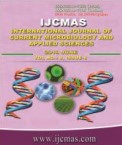


 National Academy of Agricultural Sciences (NAAS)
National Academy of Agricultural Sciences (NAAS)

|
PRINT ISSN : 2319-7692
Online ISSN : 2319-7706 Issues : 12 per year Publisher : Excellent Publishers Email : editorijcmas@gmail.com / submit@ijcmas.com Editor-in-chief: Dr.M.Prakash Index Copernicus ICV 2018: 95.39 NAAS RATING 2020: 5.38 |
A field experiment was conducted at Agricultural Experimental Farm of Calcutta University, Baruipur, South 24 – Parganas, West Bengal during the during rabi season of 2016 – 2017 on Gangetic Alluvial Soil. The investigation was designed to study “Studies of foliar nutrients on productivity and quality of wheat (Triticum aestivum L.) seed under lower Gangetic alluvial soils of West Bengal”. This investigation was laid out in a Randomized block design with three replications on the Gangetic alluvial soil of lowland under well irrigated condition. There were altogether 10 treatments of supplementary foliar nutrients viz. KCl @ 0.75%; KNO3 @ 0.75%; KNO3 @ 1%; N:P:K @ 1%; N:P:K @ 1.5%; NaCl @ 0.5%; NaCl @ 0.75%; K2SO4 @ 0.5%; K2SO4 @ 0.75% along with water spray at 50% flowering and grain filling stages. The result in general, indicates that foliar applications of nutrients had a great influence on yield contributing characters and grain yield of wheat. The investigation clearly shows that significantly highest seed yield was recorded with foliar application of NaCl @ 0.5%. Simultaneously lowest seed yield observed from only water sprayed control treatment. The seed yield was increased up to 27.92% with the application of NaCl @ 0.5%. Similar trends were also noticed in yield contributing characters of the crop. Sole application of nutrients viz. NaCl @ 0.5%; NaCl @ 0.75%; KCl @ 0.75%; KNO3 @ 0.75%; KNO3 @ 1%; N:P:K @ 1%; N:P:K @1.5%; K2SO4 @ 0.5 %; K2SO4 @ 0.75% at 50% flowering on wheat was also recorded statistically higher grain yield and higher protein content over water sprayed control treatment. The findings found at this study can be used in management recommendations of wheat.
 |
 |
 |
 |
 |